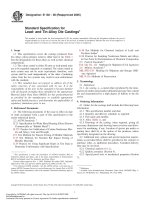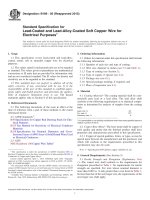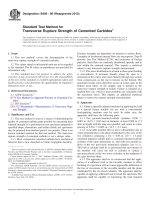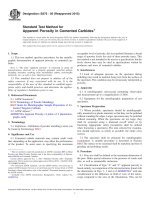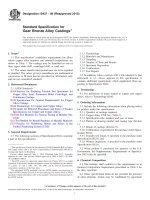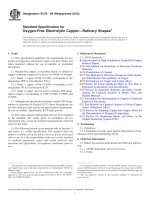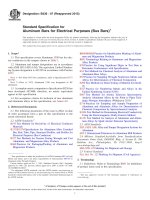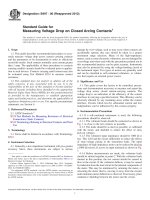Astm b 836 00 (2015)
Bạn đang xem bản rút gọn của tài liệu. Xem và tải ngay bản đầy đủ của tài liệu tại đây (88.82 KB, 4 trang )
Designation: B836 − 00 (Reapproved 2015)
Standard Specification for
Compact Round Stranded Aluminum Conductors Using
Single Input Wire Construction1
This standard is issued under the fixed designation B836; the number immediately following the designation indicates the year of
original adoption or, in the case of revision, the year of last revision. A number in parentheses indicates the year of last reapproval. A
superscript epsilon (´) indicates an editorial change since the last revision or reapproval.
B354 Terminology Relating to Uninsulated Metallic Electrical Conductors
B400 Specification for Compact Round Concentric-LayStranded Aluminum 1350 Conductors
B609/B609M Specification for Aluminum 1350 Round
Wire, Annealed and Intermediate Tempers, for Electrical
Purposes
B800 Specification for 8000 Series Aluminum Alloy Wire
for Electrical Purposes—Annealed and Intermediate Tempers
B801 Specification for Concentric-Lay-Stranded Conductors
of 8000 Series Aluminum Alloy for Subsequent Covering
or Insulation
B830 Specification for Uniform Test Methods and Frequency
E29 Practice for Using Significant Digits in Test Data to
Determine Conformance with Specifications
E527 Practice for Numbering Metals and Alloys in the
Unified Numbering System (UNS)
2.3 ANSI Standard:
ANSI H35.1 Alloy and Temper Designation Systems for
Aluminum3
2.4 NIST Standard:
Handbook 100 Copper Wire Tables NBS 4
1. Scope
1.1 This specification covers aluminum/single input wire
(SIW) stranded conductors made from round or shaped wires
for use in covered or insulated electrical wires or cables. These
conductors shall be composed of one or more roller or die
compacted layers of helically applied wires (Explanatory Note
1, Explanatory Note 2, and Explanatory Note 3).
1.2 The values stated in inch-pound units are to be regarded
as standard. The values given in parentheses are mathematical
conversions to SI units that are provided for information only
and are not considered standard.
1.2.1 For density, resistivity, and temperature, the values
stated in SI units are to be regarded as standard.
NOTE 1—The aluminum and temper designations conform to ANSI
H35.1. Aluminum 1350 and Aluminum-Alloy 8XXX correspond to
Unified Numbering System A91350 and A98XXX, in accordance with
Practice E527.
1.3 This standard does not purport to address all of the
safety concerns, if any, associated with its use. It is the
responsibility of the user of this standard to establish appropriate safety and health practices and determine the applicability of regulatory limitations prior to use.
2. Referenced Documents
3. Classification
2.1 The following documents of the issue in effect on date
of material purchase form a part of this specification to the
extent referenced herein.
3.1 The conductors described in this specification are intended for subsequent insulation or covering. The classification
of these conductors is SIW Compact.
2.2 ASTM Standards:2
B230/B230M Specification for Aluminum 1350–H19 Wire
for Electrical Purposes
B263 Test Method for Determination of Cross-Sectional
Area of Stranded Conductors
4. Ordering Information
4.1 Orders for material in accordance with this specification
shall include the following information:
4.1.1 Quantity of each size and class (Table 1);
4.1.2 Conductor size, circular-mil area or AWG (Section 7);
4.1.3 Temper (Section 12);
4.1.4 Lay direction, if nonstandard (see 6.2 and 6.3);
4.1.5 Special tension test, if required (see 16.2);
1
This specification is under the jurisdiction of ASTM Committee B01 on
Electrical Conductors and is the direct responsibility of Subcommittee B01.07 on
Conductors of Light Metals.
Current edition approved Oct. 1, 2015. Published October 2015. Originally
approved in 1993. Last previous edition approved in 2011 as B836 – 00 (2011).
DOI: 10.1520/B0836-00R15.
2
For referenced ASTM standards, visit the ASTM website, www.astm.org, or
contact ASTM Customer Service at For Annual Book of ASTM
Standards volume information, refer to the standard’s Document Summary page on
the ASTM website.
3
Available from American National Standards Institute (ANSI), 25 W. 43rd St.,
4th Floor, New York, NY 10036, .
4
Available from National Institute of Standards and Technology (NIST), 100
Bureau Dr., Stop 1070, Gaithersburg, MD 20899-1070, .
Copyright © ASTM International, 100 Barr Harbor Drive, PO Box C700, West Conshohocken, PA 19428-2959. United States
1
B836 − 00 (2015)
TABLE 1 Construction of Compact Round, Concentric-Lay-Stranded Aluminum Conductors
Conductor Size
A
2
Circular, mils
AWG
mm
1 000 000
900 000
800 000
750 000
700 000
650 000
600 000
550 000
500 000
450 000
400 000
350 000
300 000
250 000
211 600
167 800
133 100
105 600
83 690
66 360
52 620
41 740
26 240
16 510
...
...
...
...
...
...
...
...
...
...
...
...
...
...
0000
000
00
0
1
2
3
4
6
8
507
456
405
380
355
329
304
279
253
228
203
177
152
127
107
85.0
67.4
53.5
42.4
33.6
26.7
21.2
13.3
8.37
Minimum
Number of
Wires
53
53
53
53
34
34
34
34
30
30
24
24
18
18
17
15
12
7
7
6
6
6
6
6
Nominal Compact Conductor
Diameter
in.
1.060
0.999
0.938
0.908
0.877
0.845
0.813
0.775
0.736
0.700
0.659
0.616
0.570
0.520
0.475
0.423
0.376
0.336
0.299
0.268
0.238
0.213
0.169
0.134
mm
Nominal
Mass/1000
ft,A lb
Nominal
Mass/km, kg
26.9
25.4
23.8
23.1
22.3
21.5
20.7
19.7
18.7
17.8
16.7
15.6
14.5
13.2
12.1
10.7
9.55
8.53
7.59
6.81
6.05
5.41
4.29
3.40
937
844
750
703
656
609
563
516
468
422
375
328
281
234
198
157
125
98.9
78.4
62.2
49.3
39.1
24.6
15.5
1394
1257
1116
1046
976
906
838
768
696
628
558
488
418
348
295
234
186
147
117
92.6
73.3
58.2
36.6
23.1
Nominal dc Resistance at 20°C
Ω/1000 ft
Ω/km
0.0173
0.0193
0.0217
0.0231
0.0248
0.0267
0.0289
0.0315
0.0347
0.0385
0.0434
0.0495
0.0578
0.0694
0.0820
0.103
0.130
0.164
0.207
0.261
0.330
0.416
0.661
1.05
0.0563
0.0632
0.0712
0.0759
0.0813
0.0875
0.0948
0.103
0.114
0.126
0.142
0.162
0.190
0.228
0.269
0.338
0.428
0.539
0.680
0.857
1.08
1.36
2.17
3.44
Weights are based on Aluminum 1350 with a density of 0.0975 lb/in.3
8. Rated Strength of Conductor
4.1.6 Place of inspection (Section 17);
4.1.7 Packaging and package marking (Section 18), and
4.1.8 Material for conductor.
8.1 The rated strength of SIW conductors made from any
and all alloys and tempers covered in this specification shall be
taken as the percentage, indicated in Table 2, of the sum of the
strengths of the component wires, calculated on the basis of the
equivalent diameter of these wires and the specified minimum
average tensile strengths given in Specifications B230/B230M,
B609/B609M, and B800.
5. Joints
5.1 Joints may be made in any of the wires of any stranding
by electric-butt welding, cold-pressure welding, or electricbutt, cold-upset welding.
5.1.1 Joints in the individual wires in a finished conductor
shall not be closer together than 1 ft (0.3 m) for conductors of
19 wires or less, or closer than 1 ft (0.3 m) in a layer for
conductors of more than 19 wires.
8.2 Rated-strength and breaking-strength values shall be
rounded to three significant figures, in the final value only, in
accordance with the rounding method of Practice E29.
8.3 Rated strengths of conductors are given in Table 3 of
Specification B400 for conductors made of Aluminum 1350 in
all tempers.
5.2 No joint or splice shall be made in a stranded conductor
as a whole.
8.4 Rated strengths of conductors made from any and all
tempers of 8000 series aluminum alloys are given in Table 3 of
Specification B801.
6. Lay
6.1 The length of lay of each layer for SIW conductors shall
not be less than 8 or more than 17.5 times the outside diameter
of the finished conductor.
9. Density
6.2 The direction of lay of the outer layer shall be left-hand
and may be reversed or unidirectional in successive layers.
9.1 For the purpose of calculating mass, cross-sections, and
so forth, the density of Aluminum 1350 shall be taken as 2705
6.3 Other lay requirements may be furnished upon special
agreement between the manufacturer and the purchaser.
TABLE 2 Rating Factors
7. Construction
7.1 The construction of the conductors shall be as given in
Table 1.
7.2 Wire used in the fabrication of conductors shall be of
such dimensions as to produce a finished conductor as prescribed in Table 1.
2
Stranding
Number of Layers
Rating Factor, %
1
2
3
4
96
93
91
90
B836 − 00 (2015)
TABLE 3 Temperature Correction Factors for Conductor
Resistance
Temperature,° C
Multiplying Factor for Conversion to 20°C
0
5
10
15
20
25
30
35
40
45
50
55
60
65
70
75
80
85
90
1.088
1.064
1.042
1.020
1.000
0.980
0.961
0.943
0.925
0.908
0.892
0.876
0.851
0.846
0.832
0.818
0.805
0.792
0.780
12.3 For conductors made from all other alloys and tempers
covered in this specification with shaped wires, the tensile
requirements for the wires shall be the same as those for round
input wires of equal nominal area. The area tolerances for
shaped wire of all alloys and tempers shall be such that the
finished conductor conforms to Section 13.
13. Variation in Area
13.1 The cross-sectional area of the conductor shall not be
less than 98 % of the cross-sectional area as specified in
Column 1 of Table 1.
13.2 The manufacturer shall determine the cross-sectional
area by Test Method B263. In applying this test method, the
increment in weight resulting from stranding may be the
applicable value specified in 10.1, or it may be calculated from
the measured dimensions of the sample under test. In case of a
question regarding area compliance, the actual weight increment due to stranding shall be calculated.
NOTE 2—The term “weight” is used in this specification because of
established trade usage in place of the technically correct term “mass.”
kg/m3 (0.0975 lb/in.3) at 20°C, and the density of 8000 series
aluminum alloys shall be taken as 2710 kg/m3 (0.098 lb/in.3)
at 20°C.
14. Variation in Diameter
14.1 The average diameter of the conductor shall vary by
not more than plus 1 % and minus 2 % from the diameter
specified in Table 1.
10. Mass and Resistance
10.1 The mass and electrical resistance of a unit length of
stranded conductor is a function of the length of lay. The
approximate weight and electrical resistance may be determined using an increment of 2 %. When greater accuracy is
desired, the increment based on the specific lay of the conductor may be calculated (Explanatory Note 4).
15. Sampling
15.1 The aluminum cross-sectional area (Section 13) and
diameter (Section 14) shall be measured on a sample of
completed conductor. At least one sample shall be tested on
each size of conductor on each order of quantities from 5000 to
100 000 ft (1500 to 30 000 m), and one additional sample shall
be tested from each 100 000 ft (30 000 m) thereafter.
10.2 The maximum electrical resistance of a unit length of
stranded conductor shall not exceed the nominal dc resistance
(Table 1), plus 2 %.
10.2.1 When the dc resistance is measured at other than
20°C, it is to be corrected by using the multiplying factor given
in Table 3.
15.2 In addition or instead of the acceptance testing outlined
in 15.1, the sampling may be in accordance with Specification
B830 (see Explanatory Note 5).
10.3 For conductors to be used in covered or insulated wires
or cables, dc resistance measurement may be used instead of
the method outlined in Section 13, to determine compliance
with this specification; however, the referee method shall be
that outlined in Section 13.
16. Mechanical and Electrical Tests of SIW Conductors
16.1 Tests for the mechanical and electrical properties of
wire composing the conductor shall be made before, but not
after, stranding unless otherwise agreed upon by the manufacturer and the purchaser as provided in 16.2 (Explanatory Note
6).
11. Workmanship, Finish, and Appearance
11.1 The conductor shall be clean and free of imperfections
not consistent with good commercial practice.
16.2 At the option of the purchaser, at the time of placing
the order, tensile and elongation tests of wire before stranding
may be waived, and the completed conductor may be tested as
a unit. The minimum breaking strength of the conductors so
tested shall not be less than the rated strength of the conductor
(per Section 8 of this specification) if failure occurs in the free
length at least 1 in. (25 mm) beyond the end of either gripping
device, or it shall not be less than 95 % of the rated strength if
failure occurs inside, or within, 1 in. (25 mm) of the end of
either gripping device. The maximum breaking strength for
tempers other than -H19 shall not be greater than their
maximum rated strengths as provided in Section 9 of this
specification and in Table 3 of Specification B400 and Table 3
of Specification B801. The free length between grips of the test
12. Requirements of Wires
12.1 Before stranding and compacting, the round input wire
used shall meet the requirements of Specifications B230/
B230M, B609/B609M, or B800, whichever is applicable.
12.2 Wire shaped before stranding shall meet the requirements of the appropriate specification listed in 12.1 except for
tensile and elongation requirements and diameter tolerance.
For the 1350-H19 temper, the minimum tensile and elongation
requirements shall be 96 % of those for round wire of the same
nominal area, provided the completed conductor is capable of
meeting the requirements of Sections 8 and 16.
3
B836 − 00 (2015)
18.2 The conductors shall be protected from damage during
ordinary handling and shipping.
specimen shall not be less than 24 in. (600 mm), and care shall
be taken to ensure that the wires in the conductor are gripped
evenly during the test (Section 8 and Explanatory Note 7).
18.3 There shall be only one length of conductor on a reel
unless otherwise agreed upon by the manufacturer and purchaser at the time of placing the order.
17. Inspection
17.1 Unless otherwise specified in the contract or purchase
order, the manufacturer shall be responsible for the performance of all inspection and test requirements specified.
17.2 All inspections and tests shall be made at the place of
manufacture unless otherwise especially agreed upon between
the manufacturer and the purchaser at the time of the purchase.
17.3 The manufacturer shall afford the inspector representing the purchaser all reasonable facilities to satisfy him that the
material is being furnished in accordance with this specification.
18.4 The net weight, length (and number of lengths, if more
than one length is included in the package), size, kind of
conductor, and purchase order shall be marked on a tag
attached to the end of the conductor inside of the package. The
same information, together with the manufacturer’s serial
number (if any) and all shipping marks required by the
purchaser, shall appear on the outside of each package.
19. Keywords
18. Packaging and Package Marking
18.1 Package sizes for conductors shall be agreed upon by
the manufacturer and the purchaser during the placing of
individual orders.
19.1 aluminum; aluminum stranded conductors; compact;
concentric lay stranded conductors; electrical conductors; reverse concentric; Single Input Wire; SIW; SIW Compact;
unidirectional; unilay
EXPLANATORY NOTES
NOTE 1—In this specification, only compact round/SIW conductor
constructions are specifically designated. Constructions not included in
this specification should be specifically agreed upon by the manufacturer
and the purchaser when placing the order.
NOTE 2—For definitions of terms relating to conductors, refer to
Terminology B354.
NOTE 3—Single Input Wire Construction—A stranded conductor design
methodology that varies the number of wires within a range of conductor
sizes in order to permit that range of conductor sizes to be constructed
from a single wire size.
NOTE 4—The increment of weight or electrical resistance of a completed concentric-lay-stranded conductor (k), in %, is as follows:
length of lay
diameter of helical path of the wire
The derivation of the above as given in NBS Handbook 100 is based on
round wire constructions that are applicable to compacted wire constructions.
NOTE 5—Cumulative historic results secured on the product of a single
manufacturer indicating a record of continual conformance of that product
with the requirements of this specification are necessary to ensure that the
sample can be assumed to be representative of the lot and that the
conformance criteria will largely ensure compliance of the lot with this
specification. The sample sizes and conformance criteria are applicable
only to lots produced by manufacturers that meet this requirement.
NOTE 6—Individual wires should not be unlaid from compact round
conductors for testing purposes. Some physical properties of the individual compacted wires may be altered by the deformation brought about
by compacting, unlaying, and straightening for test.
NOTE 7—To test stranded conductors for breaking strength successfully
as a unit requires adequate means of gripping the ends of the test specimen
without causing damage that may result in a failure below the actual
strength of the conductor. Various means are available, such as compression sleeves, split sleeves, and performed grips, but ordinary jaws or
clamping devices are usually not suitable.
n5
k 5 100 ~ m 2 1 !
where m = the stranding factor and is also the ratio of the weight of
electrical resistance of a unit length of stranded conductor to that of a solid
conductor of the same cross-sectional area or of a stranded conductor with
infinite length of lay, that is, all wires parallel to the conductor axis. The
stranding factor m for the completed stranded conductor is the numerical
average of the stranding factors for each of the individual wires in the
conductor, including the straight core wire, if any (for which the stranding
factor is unity). The stranding factor (mind) for any given wire in a
concentric-lay-stranded conductor is as follows:
m ind=11 ~ 9.8696/n 2 !
where:
ASTM International takes no position respecting the validity of any patent rights asserted in connection with any item mentioned
in this standard. Users of this standard are expressly advised that determination of the validity of any such patent rights, and the risk
of infringement of such rights, are entirely their own responsibility.
This standard is subject to revision at any time by the responsible technical committee and must be reviewed every five years and
if not revised, either reapproved or withdrawn. Your comments are invited either for revision of this standard or for additional standards
and should be addressed to ASTM International Headquarters. Your comments will receive careful consideration at a meeting of the
responsible technical committee, which you may attend. If you feel that your comments have not received a fair hearing you should
make your views known to the ASTM Committee on Standards, at the address shown below.
This standard is copyrighted by ASTM International, 100 Barr Harbor Drive, PO Box C700, West Conshohocken, PA 19428-2959,
United States. Individual reprints (single or multiple copies) of this standard may be obtained by contacting ASTM at the above
address or at 610-832-9585 (phone), 610-832-9555 (fax), or (e-mail); or through the ASTM website
(www.astm.org). Permission rights to photocopy the standard may also be secured from the Copyright Clearance Center, 222
Rosewood Drive, Danvers, MA 01923, Tel: (978) 646-2600; />
4
